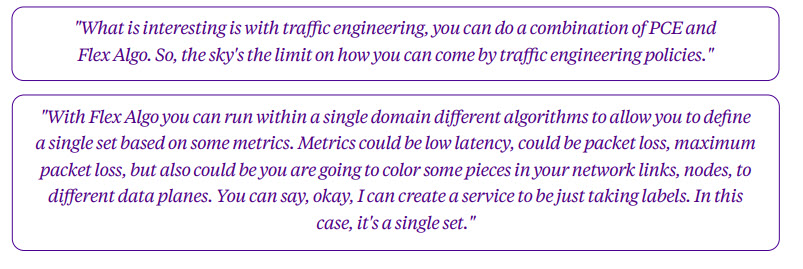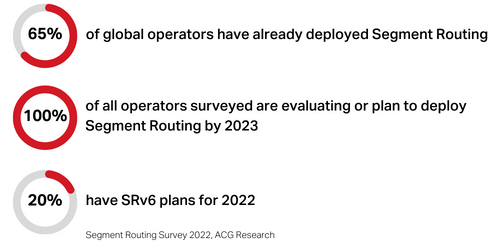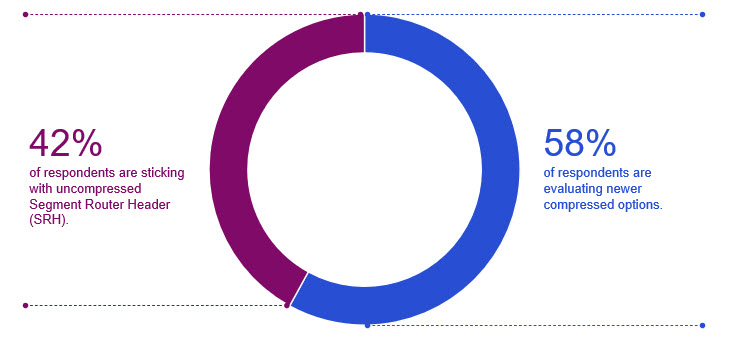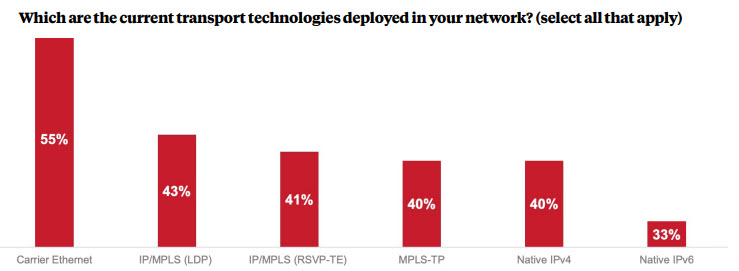Segment Routing on the rise, survey says
 Did you know there is a lot going on in Segment Routing space? In fact, this year, our industry is proud to celebrate 10 years since the introduction of Segment Routing (SR), a flexible and scalable way of implementing modern IP networks.
Did you know there is a lot going on in Segment Routing space? In fact, this year, our industry is proud to celebrate 10 years since the introduction of Segment Routing (SR), a flexible and scalable way of implementing modern IP networks.
For the past 10 years, since SR-MPLS became available, most operators have been perfectly happy adopting it. But since 2019, SR IPv6 (SRv6) has become increasingly popular, with some early SR-MPLS adopters switching to the v6 flavor.
Since SRv6 came into the picture three years ago, there’s been no engagement without questions like “why SRv6” and “why not SR-MPLS?” and vice-versa.
This dichotomy indicated to us it was a great time to gauge a greater understanding of the SR marketplace through a global study with ACG Research. Our intuition paid off. The insights gained were well worth the time invested in the project! Let’s dig into some of the results.
SR-MPLS vs. SRv6 adoption
To validate where service providers are regarding their technology decision-making roadmap, Ciena partnered with ACG Research to conduct a global survey. The responses came in from around the world. Over 63 service provider executives responded, and the results spoke loud and clear.
It is clear SR adoption won’t be short-lived. There is a steady disruption happening. This insight also matches what we are seeing in our day-to-day Routing and Switching portfolio engagements with customers. You can see the full ACG Research white paper here.
Next, we asked respondents their thoughts on SRv6 design options.
The boom of SRv6 compression
There are many SRv6 design decisions, and we wanted to gauge respondents’ preferences on a significant one: the SRv6 header.
Why? Well, an important thing to understand is that SRv6 introduces a 128-bit extension header embedded in the IPv6 packet to carry instructions; this is called a ‘segment’. And for some deployments, the 128-bit field on a 500-byte packet, as an example, incurs prohibitive transport overhead—often as high as 20%.
The industry heard the challenge loud and clear and started working on distinct compressed options to the SRv6 toolset to squash multiple instructions whereby reducing the header and optimizing the usage of the 128-bit field.
Early adopters, such as Bell Canada, are now enjoying the benefits of SRv6 and header compression. What does SRv6 mean for a service provider like Bell?
“The power of SRv6 and SRv6 header compression allows us to change the game. Before, we used to have an MPLS network that only combined P and PEs. But with SRv6, we can stretch the network, include cell sites, and compute, keeping the transport very simple while easily managing the blast radius when there is an outage.” - Dan Voyer, Technical Fellow, Bell Canada
But based on the above, you may think compression is always the way to go, right? Not necessarily. The survey revealed that:
While SRv6 deserves its own blog, you can watch ACG's Ray Mota and Ciena's Jahanzeb Baqai discuss SRv6 design options and much more here.
What about the applications?
We then asked respondents about their sentiments on the applications they’re using or plan to use with SR. Interestingly, more than 40% see SR helping them capture tomorrow’s market requirements for 5G, while advancing their network protection schemes, SDN and traffic engineering capabilities.
What stood out in the in-depth interviews is a fair share of respondents are combining instructions in interesting ways. For instance, coupling modern controllers with traffic engineering capabilities to run networks more efficiently and hotter.

These statements are in line with what we are seeing in the field too. Because a modern controller performs very advanced SR path computations that leverage other instructions – such as anycast segment identifiers (SIDs), binding SIDs, etc. -- these more powerful instructions enhance the application of SR far beyond what it is imagined today.
At the end of the day, we should keep in mind that a segment represents any instruction—topological or service based. So, an IPv6 segment can identify any object, content or function applied to an object. This aspect will likely extend SR’s impact beyond infrastructure use cases. But are operators truly considering advanced SRv6 use cases beyond infrastructure? Only time will tell.
I’m ready to deploy SR. What’s next?
It would be shortsighted to say it’s plug-and-play to deploy SR, as there are many complex networks out there.
In fact, when service providers were asked, “which are the current transport technologies deployed in your network?” the survey showed all respondents have distinct, and therefore unique, starting points in their transport selections before migrating to SR.
The question then becomes, what’s a good convergence strategy framework when it comes to SR?
One option is to bring everything to SR-MPLS first and then to SRv6 for greenfield. Another option is to deploy SRv6 and SR-MPLS everywhere, keeping an RSVP-TE core untouched. Both are concrete phased approaches. If you are deploying SR, don’t miss this podcast with Jahanzeb Baqai’s color commentary on what’s being deployed in real networks.
Bottom line: An Adaptive IPTM approach
SR is a rich area. There’s a lot more to dive into, but hopefully I’ve given you a taste of the status of the technology and some things to chase after if you want to learn more. Remember you can see all the findings from the survey in this ACG white paper.
We’re already building the next-generation metro and edge, laying important Adaptive IP groundwork for an architecture that is ultimately finding traction industry-wide. But which SR technology flavor will prevail is yet to be determined.
At Ciena, we keep enhancing SR capabilities throughout our portfolio, as customer demands warrant. And as an industry, we must continue working hard to ensure that we can exceed the business benefits that our customers enjoy today in the not-so-distant future.









